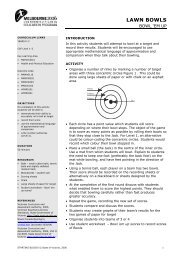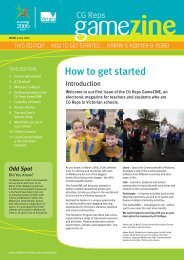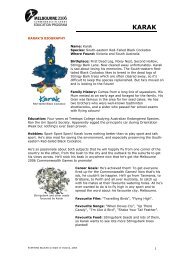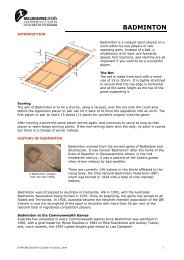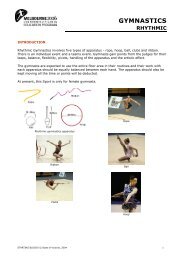basketball
basketball
basketball
Create successful ePaper yourself
Turn your PDF publications into a flip-book with our unique Google optimized e-Paper software.
BASKETBALL<br />
BASKETBALL JONES<br />
CURRICULUM LINKS<br />
YEARS 3–6<br />
CSF Levels 3–4<br />
Key Learning Area<br />
• Health and Physical Education<br />
Outcome code<br />
• HPMP0301<br />
• HPMP0302<br />
• HPMP0401<br />
• HPMP0402<br />
OBJECTIVES<br />
On completion of this activity<br />
students will be able to<br />
• describe the basic rules of travel<br />
and double dribble in Basketball<br />
• demonstrate dribbling and<br />
passing skills<br />
• perform dribbling and passing<br />
skills in a minor game situation<br />
• apply the rules of travel and<br />
double dribble to their own<br />
performances.<br />
DURATION<br />
80 minutes<br />
RESOURCES<br />
• at least one <strong>basketball</strong> between<br />
two students<br />
• witches hats or plastic marker<br />
cones to designate areas<br />
REFERENCES<br />
Victorian Curriculum and<br />
Assessment Authority, 2005,<br />
Victorian Essential Learning<br />
Standards, State Government of<br />
Victoria, http://vels.vcaa.vic.edu.au<br />
Victorian Curriculum and<br />
Assessment Authority, 2004<br />
CSF II CD-ROM<br />
State Government of Victoria<br />
http://csf.vcaa.vic.edu.au/<br />
INTRODUCTION<br />
Students learn the basic skills of passing and dribbling a<br />
<strong>basketball</strong> and identify and practise rules associated with these<br />
skills.<br />
PRIOR LEARNING<br />
Before undertaking this activity, students should already have<br />
ability to catch, ball bounce and dodge.<br />
Previous <strong>basketball</strong> experience would be an advantage.<br />
ACTIVITY<br />
Warm-up<br />
• Play a game of zig-zag relay. Organise students into teams.<br />
Place four witches hats in a zig-zag pattern between the ends.<br />
Students touch the top of each cone as they run to the other<br />
end.<br />
• Body wraps with ball – pass ball around body<br />
• Tap ball between fingers above head (CSF 4)<br />
• Wrap (pass) ball around leg<br />
• Dribble ball on dominant side of body, for example, if righthanded<br />
use right hand<br />
• Dribble ball on non dominant side of body<br />
• Dribble ball around partner’s body (CSF 3)<br />
• Dribble ball around legs in a figure eight (CSF 4)<br />
• Discussion of double dribble rule – use of one hand<br />
Class activity<br />
• Students line up at end of court. In groups of six, jog length<br />
of court and astride stop at four designated spots (or on<br />
whistle).<br />
• As above, but students jump stop (two feet together) at four<br />
designated spots on court (or on whistle).<br />
• Discussion of travel rule – why do we have rules (CSF 4)?<br />
• Game of ‘keepings off’ with emphasis on footwork and travel<br />
rule.<br />
• Dribble work<br />
o<br />
o<br />
o<br />
In pairs, students sit opposite each other on the ground.<br />
One partner dribbles ball. Other partner holds up fingers<br />
so that the fingers add up to a score between 1 and 10.<br />
The dribbling partner verbally confirms to other partner<br />
the number of fingers held up, while continuing to<br />
dribble the ball.<br />
• Students sit down and dribble on one side of body. On whistle<br />
they must continue the dribble and move to knees, on next<br />
whistle they move to a standing position, on next whistle the<br />
ball is switched to opposite side and the procedure continues<br />
in reverse until the student is sitting down again (CSF 4).<br />
STARTING BLOCKS © State of Victoria, 2006 1
BASKETBALL<br />
BASKETBALL JONES<br />
• Game of dribble tag<br />
All students have a <strong>basketball</strong>. In a restricted area ½ to ¾ of<br />
the students dribble and try to hit the other students’<br />
<strong>basketball</strong>s away while maintaining control of their own. If a<br />
student loses control of their ball they hand the ball to the<br />
next student in line outside the court. The student, having<br />
passed the ball to the next student, joins the end of the line.<br />
Class discussion<br />
• What skills are important in the game Basketball (move<br />
quickly, jump, shoot, stay close to your opposition player)?<br />
• What fitness skills would you need to play <strong>basketball</strong> well?<br />
• Why? (CSF 3)<br />
TEACHING NOTES<br />
• Footwork skills can be learned initially by shadowing teacher<br />
before going into line drills.<br />
• In dribbling drills concentrate on fingertip control. Encourage<br />
older students to take eyes off ball.<br />
• In line drills use cones to divide court into three (foul line,<br />
centre line, foul line). Do not have students doing drills on<br />
end line (near walls), as they may not be able to control<br />
momentum.<br />
ASSESSMENT<br />
• Develop a criteria checklist for evaluating students ability to<br />
perform a dribble (consideration need to be given to order of<br />
introduction and mastery of skills when assessing):<br />
o<br />
o<br />
o<br />
o<br />
o<br />
eyes directed forward throughout the bounce<br />
ball contact with fingers of one hand at about hip<br />
height<br />
wrist and elbows bend then straighten to push<br />
the ball<br />
hips and knees slightly flexed during the bounce<br />
ball bounces in front of and to the side of the<br />
body<br />
SUGGESTIONS FOR DEEPER LEARNING<br />
• Revisit SOSE material related to purpose of rules.<br />
• Discuss the different roles people can play in teams and how<br />
that transfers to activities beyond sport.<br />
STARTING BLOCKS © State of Victoria, 2006 2
BASKETBALL<br />
BASKETBALL JONES<br />
Victorian Essential Learning Standards<br />
Strand: Physical, Personal and Social Learning<br />
Domain: Health and Physical Education<br />
Dimension Level Key elements of standards<br />
Students:<br />
Movement 3 • perform a broad range of complex motor skills<br />
and physical<br />
activity<br />
• demonstrate a wide variety of motor skills and<br />
apply them to basic, sport-specific situations<br />
• create and perform coordinated movement<br />
sequences that contain a variety of motor skills<br />
and movement patterns<br />
• participate regularly in physical activities for the<br />
purpose of improving skill and health, and<br />
identify and describe the components of healthrelated<br />
fitness<br />
• work with others to achieve goals in both<br />
cooperative and competitive sporting and<br />
games situations, understand the concept of fair<br />
play, and respect the roles of officials<br />
• follow safety principles in games and activities<br />
Movement<br />
and physical<br />
activity<br />
4 • perform confidently and efficiently in a range of<br />
movement environments<br />
• refine basic and complex motor skills and apply<br />
these skills in increasingly complex games and<br />
activities<br />
• effectively use strategic thinking and work with<br />
both more- and less- skilled peers to improve<br />
game performance<br />
• maintain regular participation in moderate to<br />
vigorous physical activity and monitor exercise<br />
intensity<br />
Other Standards which could be applied to this activity include:<br />
Physical, Personal and Social Learning<br />
• Personal Learning<br />
- Managing personal learning<br />
STARTING BLOCKS © State of Victoria, 2006 3



